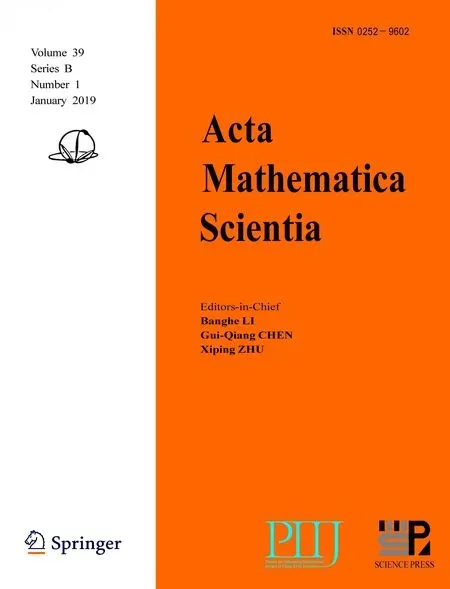STABILITY OF BOUNDARY LAYER TO AN OUTFLOW PROBLEM FOR A COMPRESSIBLE NON-NEWTONIAN FLUID IN THE HALF SPACE?
Jie PANLi FANGZhenhua GUO
Center for Nonlinear Studies,Department of Mathematical,Northwest University,Xi’an 710127,China
E-mail:201520485@stumail.nwu.edu.cn;fangli@nwu.edu.cn;zhguo@nwu.edu.cn
Abstract This paper investigates the large-time behavior of solutions to an out fl ow problem for a compressible non-Newtonian fl uid in a half space.The main concern is to analyze the phenomena that happens when the compressible non-Newtonian fl uid blows out through the boundary.Based on the existence of the stationary solution,it is proved that there exists a boundary layer(i.e.,the stationary solution)to the out fl ow problem and the boundary layer is nonlinearly stable under small initial perturbation.
Key words compressible non-Newtonian fl uid;stability;boundary layer
1 Introduction
The main purpose of the present paper is to investigate the initial-boundary-value problem(IBVP)for the one-dimensional compressible non-Newtonian fl uid on the half line R+:=(0,∞)which reads in Eulerian coordinates

with α >2 and μ0>0 being given constants,where ρ(x,t)>0 and u(x,t)stand for the mass density and the velocity of the fl uid respectively.p(ρ)=aργis the pressure,where a>0 and the exponent γ>1 are fi xed constants.The initial-boundary-value problem of system(1.1)in the fi rst half space R+,is considered with the initial data and boundary condition as

where ρ+,u+and ubare constants.In addition,the compatibility conditions on u(x,t)of order 0 and 1 is assumed to hold at the origin(x,t)=(0,0).The situation ub<0 means that the fl uid fl ows away from the boundary{x=0},and hence the problem(1.1)–(1.3)is called out fl ow problem(see in[14]).Based on the fact that the characteristic speed of the fi rst hyperbolic equation(1.1)1is negative around the boundary{x=0}due to(1.3),it is worth noticing that only one boundary condition(1.3)on{x=0}is necessary and sufficient for the well-posedness of this problem(the detailed analysis can be found in[8]).
For compressible non-Newtonian fl uids,M′alek and his cooperator established the existence of measure-valued weak solutions of initial boundary problem for multidimensional non-Newtonian fl uids in[12].Zhikov and Pastukhova obtained the existence of weak solutions of initial boundary value problem for multidimensional non-Newtonian fl uids under some restriction in[18].Mamontov established the global existence of sufficiently regular solutions to two-dimensional and three-dimensional equations of compressible non-Newtonian fl uids in[13].Fang and Li proved the local existence of classical solutions for a compressible non-Newtonian fl uid with vacuum under some assumption[4].Recently,Feireisl and his cooperator considered the global weak solutions to a class of compressible non-Newtonian fl uid in[5].Later,Yuan and his cooperators proved the local existence and uniqueness of the strong solutions of the initial boundary value problem in one space dimension with vacuum see[19]and the references therein.More result on compressible non-Newtonian fl uids can be found in[5,18–20]and their reference.
The stability of hyperbolic waves to the one-dimensional Cauchy problem for compressible non-Newtonian fl uid is another issue.There are few results on this issue except the work of Shi in[17]and the work of Fang and Guo in[3].In order to consider the stability of boundary layer to an out fl ow problem without vacuum for a compressible non-Newtonian fl uid in the half space,we brie fl y recall Matsumura’s classi fi cation concerning boundary layer in[14](also see[6]).The characteristic speeds of the corresponding hyperbolic system of(1.1)are

where S(ρ)is the local sound speed de fi ned by

A new function v(x,t)is introduced,which denotes the speci fi c volume,i.e.,v=and thus ν>0 for simplicity of statement.Let(v,u)-space be the phase plane which is divided into three sets

where ?sub, Γtransand ?superare called the subsonic,transonic and supersonic regions,respectively.Obviously,Γtransand ?superare not connected,and if adding the alternative condition u ? 0,then there are six connected subsetsIn the phase plane,the curves through a point(v1,u1)are denoted

2 Preliminaries and Main Results


As the solution to the out fl ow problem(1.1)–(1.3)is expected to tend to the superposition of a degenerate boundary layer connecting(ρb,ub)with(ρ?,u?)and a rarefaction wave connecting(ρb,ub)with(ρ+,u+)as t → ∞,one consider the Riemann problem for the typical Burgers equation

If w? Moreover,one can consider the following Cauchy problem for the Burgers’equation where δr:=w+?w?,q>10 is some fi xed constant,Cqis a constant such that1,and ? 6 1 is a small positive constant to be determined later.So,one can fi nd the properties of smooth solutionwˉ(x,t)to(2.14)in[16],which is stated in Lemma 2.2. In order to prove the stability result stated in Theorem 2.1,it is convenient to regard the solution(ρ,u)as a perturbation from the boundary layer(?ρ,?u).Thus,one can put the perturbation(φ,ψ)(x,t)by and the reformulated form of(1.1)–(1.3)is where Let the solution space X(0,T)of(3.2)is de fi ned by where M0is a positive constant to be determined later. Note that φ2(0,τ)6 C(ρ(0,τ))(ρΦ)(0,τ).The terms I1,I2and I3can be estimated for two cases M+=1 and M+>1. When M+=1,the boundary layer(x)is degenerate,i.e.,(x)tends to(ρ+,u+)algebraically as x→∞.Since p(ρ)??φ>0 and?ux>0,one just need to estimate I1and I3.First, Then,adding(3.23)× ρp′(ρ)to the last equation above,and integrating the result equation over[0,t]×R+,one obtains that By using H?lder inequality and Lemma 2.1,one can estimate each term in the right hand of(3.24)as follows With the help of H?lder inequality and Lemma 2.1,one can estimate each term in the right side of(3.42)as follows Therefore,the a priori estimate(3.5)directly follows from(3.22),(3.40)and(3.49)by selecting δ0small enough. Now,adding(4.18)× ρp′(ρ),(4.19)and(4.20),and integrating the result equation,one can obtain that Employing the similar technique of estimate in Step 3 in Section 3,one can obtain the following estimate Then,the a priori estimate(4.4)holds directly following from(4.17),(4.38)and(4.41).Moreover,one can determine the constant M0and the lower and upper bounds of ρ by the same technique of Step 4 in Section 3.Therefore,Proposition 4.1 is proved. ? Proof of Theorem 2.2Theorem 2.2 can be proved by the local existence,Proposition 4.1 and(iii)of Lemma 2.3. ?



3 Proof of Theorem 2.1














4 Proof of Theorem 2.2











 Acta Mathematica Scientia(English Series)2019年1期
Acta Mathematica Scientia(English Series)2019年1期
- Acta Mathematica Scientia(English Series)的其它文章
- BLOW-UP OF SOLUTION FOR A VISCOELASTIC WAVE EQUATION WITH DELAY?
- CLASSFICATION OF HOMOGENEOUS TWO-SPHERES IN G(2,5;C)?
- SUBCLASSES OF BIHOLOMORPHIC MAPPINGS UNDER THE EXTENSION OPERATORS?
- A NECESSARY CONDITION FOR CERTAIN INTEGRAL EQUATIONS WITH NEGATIVE EXPONENTS?
- KAM TORI FOR DEFOCUSING KDV-MKDV EQUATION?
- EXISTENCE AND CONTROLLABILITY FOR NONLINEAR FRACTIONAL CONTROL SYSTEMS WITH DAMPING IN HILBERT SPACES?
